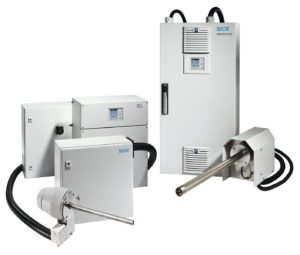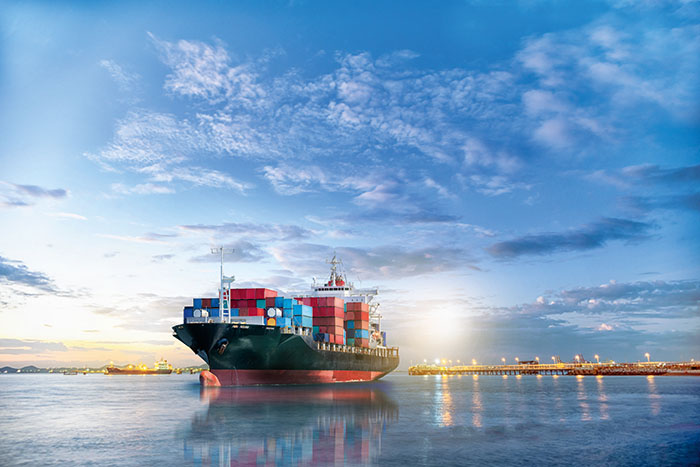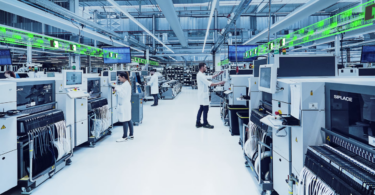Emission measurement system like SICK’s MARSIC help clean sulfur oxides from exhaust gases
To cut down on the amount of pollution emitted from ships, the Sulphur Cap 2020 law went into effect on January 1, 2020. Most ships operating on cheap, heavy fuel emit large amounts of sulfur dioxide when used. But now, the International Maritime Organization (IMO), a UNO subsidiary that is dedicated to the safety and environmental compliance of ships, has reduced the sulfur limit value in fuel from the current 3.5 percent to 0.5 percent in international waters. This limit has already been reduced to 0.1 percent in so-called Sulfur Emission Control Areas. More stringent limit values for ship emissions began in January 2020, requiring many ships to be equipped with exhaust gas cleaning systems, including a new measurement device from SICK.
Exhaust gas cleaning plants monitored by SICK
 Since January 1, these new regulations forced shipping companies and ship owners to react. All ships have two options: convert to considerably more expensive low-sulfur fuels – such as marine diesel oil, marine gas oil, or liquefied natural gas (LNG) – or retrofit an exhaust gas cleaning system (aka scrubbers) to continue using the cheaper heavy fuel.
Since January 1, these new regulations forced shipping companies and ship owners to react. All ships have two options: convert to considerably more expensive low-sulfur fuels – such as marine diesel oil, marine gas oil, or liquefied natural gas (LNG) – or retrofit an exhaust gas cleaning system (aka scrubbers) to continue using the cheaper heavy fuel.
The IMO Secretary General, Kitack Lim, reported that the price of compliant fuels rose quickly, but is now stabilizing. Since January, only 10 cases of compliant fuel being unavailable were reported.
However, many ships are opting to use scrubbers instead of switching fuel sources. With scrubbers, ships can continue using the same type of fuel that is cheaper, but needs to have sulfur oxides cleaned from it. These scrubbers are installed in combination with an emission measurement system to clean the sulfur oxides from the exhaust gases. SICK’s MARSIC is one such measurement device that is available.
“We specifically developed our MARSIC measurement device for maritime emission measurement,” explained Hinrich Brumm, Strategic Industry Manager Combustion Engines and Maritime. “It ensures compliance with the IMO regulation and provides efficiency of the particular exhaust gas cleaning system. It is an indispensable component of the scrubber.”
The MARSIC300 (roughly 130 x 40 cm and weighing about 120 kg) can measure up to nine gas components – SO2, CO2, CO, NO, NO2, NH3, CH4, H2O and O2 – so it is also designed for other on-board process measurements.
SICK’s emission measurement devices are now approved by the seven largest classification organizations, and thus cover 90 percent of the world’s shipping fleet.
Exhaust gas desulfurization in the maritime sector
Exhaust gas desulfurization is the removal of sulfur from the waste gases produced when fuel containing sulfur is burnt on board a ship. Two potential processes are available: So-called dry scrubbers remove the sulfur from the ship’s exhaust gases using dry granules, resulting in a form of gypsum that can subsequently be disposed of on land.
Wet scrubbers use seawater for desulfurization, and there are two possibilities here. With the open-loop system, the waste gas is cleaned using seawater that is then processed and returned to the sea. This system, however, is suspected of impairing water quality in favor of air quality. Because of this, it is viewed critically. On the other hand, in the closed-loop process, the scrubbing water is maintained in a closed circulatory system and disposed of when the ship reaches port.
The shipping industry is now facing a new deadline. Starting March 1, 2020, carrying non-compliant fuel on board will be prohibited.
![]() Interested in learning more about SICK's MARSIC and how you can ensure compliance with the Sulphur Cap 2020 regulations? Contact us at info@sick.com!
Interested in learning more about SICK's MARSIC and how you can ensure compliance with the Sulphur Cap 2020 regulations? Contact us at info@sick.com!






